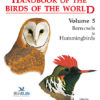Volume 5 of the Handbook of the Birds of the World covers 10 families, including barn-owls, nightjars, swifts, and hummingbirds. With 76 color plates, 406 photographs, 758 distribution maps, and nearly 8,000 bibliographical references, this volume delves into some of the most widespread and rare bird species. It includes a foreword by Nigel J. Collar on bird conservation and was awarded Outstanding Academic Title, 2000 by CHOICE.
Awarded the prestigious Outstanding Academic Title, 2000 by ‘CHOICE: Current Reviews for Academic Libraries’.
Choice publishes a list of Outstanding Academic Titles that were reviewed during the previous calendar year. This prestigious list reflects the best in scholarly titles reviewed by Choice and brings with it the extraordinary recognition of the academic library community.
Handbook of the Birds of the World, Volume 5 is a remarkable volume in the series, distinguished by the largest team of contributing experts to date—38 authors. This volume covers 10 bird families across three orders, ranging from nocturnal birds like owls and nightjars to the swift and energetic swifts and hummingbirds. The detailed and richly illustrated accounts are complemented by a foreword from Nigel J. Collar, which discusses risk indicators and the global status assessments of birds, a timely and important topic for conservationists.
This volume is essential for those interested in nocturnal species, with detailed sections on barn-owls, typical owls, and the fascinating nightjars and potoos. The swift and tree-swift families offer a glimpse into some of the most aerodynamically specialized birds, while the final family covered in this volume, the Trochilidae (hummingbirds), represents one of the most species-rich bird families, with 328 species, known for their vibrant colors and high-speed agility.
This volume spans from well-known species such as the globally distributed Barn Owl (Tyto alba) to rarities like the Forest Owlet (Heteroglaux blewitti), rediscovered in 1997 in India after being believed extinct. Other highlights include the Edible-nest Swiftlet (Aerodramus fuciphagus), whose nests made entirely of saliva are highly prized, and the Bee Hummingbird (helenae), the smallest bird in the world at just 5 cm long.
| Order STRIGIFORMES | |
| Family Tytonidae (Barn-owls) | M. D. Bruce |
| Family Strigidae (Typical Owls) | J. S. Marks, R. J. Cannings & H. Mikkola |
| Order CAPRIMULGIFORMES | |
| Family Steatornithidae (Oilbird) | B. T. Thomas |
| Family Aegothelidae (Owlet-nightjars) | D. T. Holyoak |
| Family Podargidae (Frogmouths) | D. T. Holyoak |
| Family Nyctibiidae (Potoos) | M. Cohn-Haft |
| Family Caprimulgidae (Nightjars) | N. Cleere |
| Order APODIFORMES | |
| Family Apodidae (Swifts) | P. Chantler |
| Family Hemiprocnidae (Tree-swifts) | D. R. Wells |
| Family Trochilidae (Hummingbirds) | K. L. Schuchmann |
Key Features:
- 76 colour plates and 406 photographs.
- 758 distribution maps.
- 10 figures and tables.
- Nearly 8,000 bibliographical references.
- Special emphasis on restricted-range species and Endemic Bird Areas (EBAs), highlighting their conservation significance.
Awarded Outstanding Academic Title, 2000 by CHOICE, this volume offers an in-depth exploration of some of the most widespread and rare bird species in the world.





